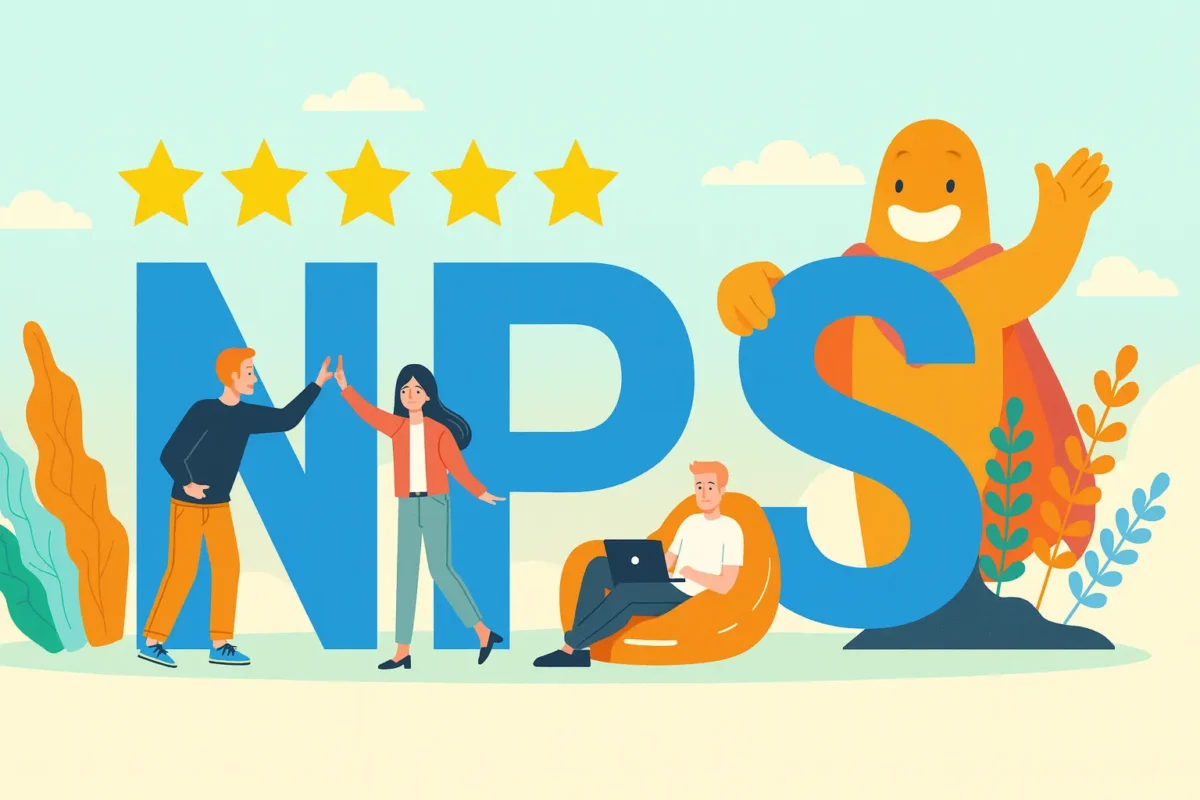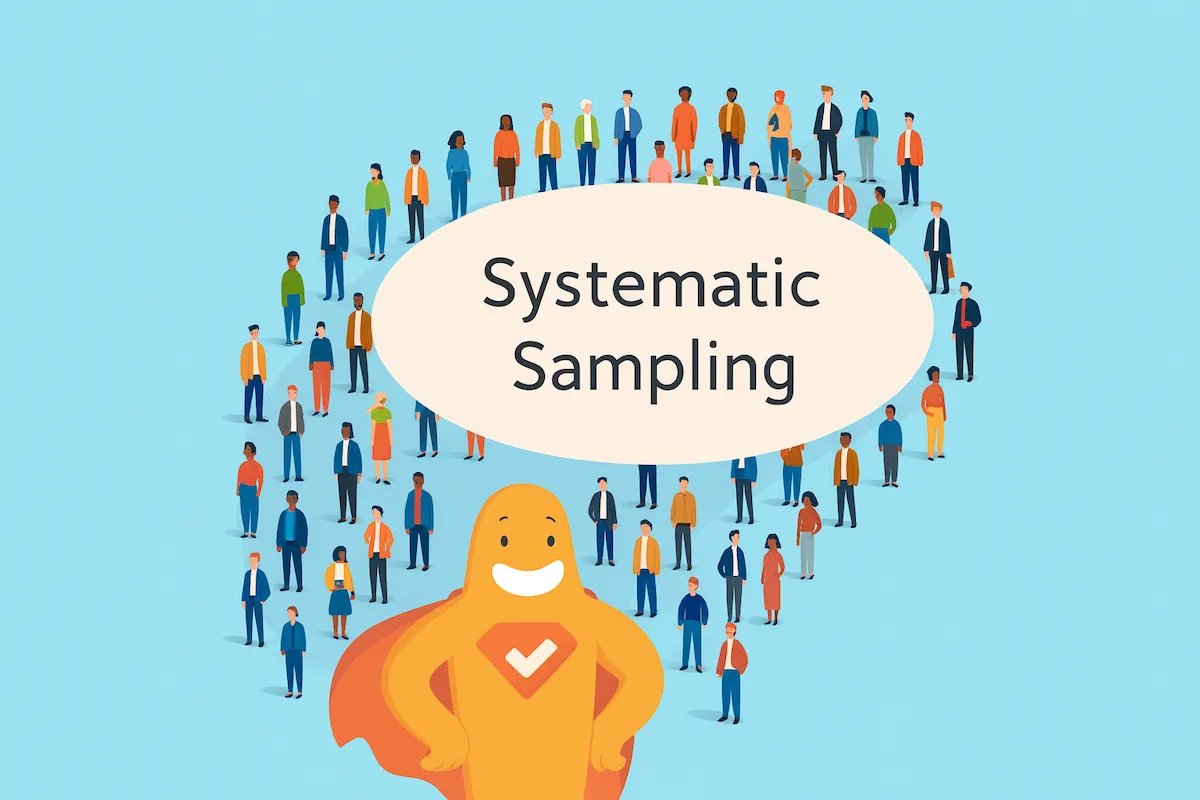A Net Promoter Score® (NPS) survey measures customer loyalty by asking one key question: how likely are customers to recommend your brand to others? Responses are categorized as promoters, passives, or detractors to calculate a score ranging from -100 to 100. NPS surveys help businesses assess customer satisfaction, predict growth, and uncover areas for improvement. This guide explains how to calculate your NPS, interpret results, and use transactional NPS for real-time feedback. It also covers key NPS questions, follow-up prompts, and best practices for survey design. When analyzed effectively, NPS data provides actionable insights to strengthen customer relationships and build brand advocacy.
Create your first NPS survey, form, or poll now!
Word of mouth is often said to be one of the best, if not the best, forms of advertising. Word of mouth marketing drives $6 trillion of annual consumer spending and is estimated to account for 13% of consumer sales. In addition, people are 90% more likely to trust and buy from a brand recommended by a friend. This makes understanding your Net Promoter Score® (NPS) and conducting NPS surveys all the more critical.
NPS is one of several customer experience metrics used to benchmark and measure overall customer satisfaction and loyalty.
Introduction to NPS Surveys
Net Promoter Score (NPS) surveys have become a cornerstone for businesses aiming to measure customer loyalty and customer satisfaction. At the heart of every NPS survey is a straightforward question: how likely is a customer to recommend your product or service to a friend or colleague? This simple approach provides deep insights into customer experiences and helps companies understand the strength of their customer relationships. By regularly conducting NPS surveys, businesses can track shifts in customer sentiment, identify loyal customers who are likely to repurchase and refer others, and spot opportunities to improve their offerings. Ultimately, using NPS surveys to measure customer loyalty is essential for building a strong customer base and driving sustainable growth, as enthusiastic customers become powerful advocates for your brand.
Create your first NPS survey, form, or poll now!
What Is a Net Promoter Score?
A Net Promoter Score (NPS) is a customer loyalty score. At the core of the NPS methodology is the NPS survey question: “How likely are you to recommend our product or service to a friend or colleague?” This standardized question is used in surveys to measure customer loyalty and satisfaction.
NPS ranges from -100 to 100, and is calculated by collecting customer responses, categorizing them into promoters, passives, and detractors, and then subtracting the percentage of detractors from the percentage of promoters to calculate NPS. This NPS methodology provides a structured approach to benchmark customer sentiment, track progress, and guide business improvements.
The result is called the NPS score, and companies track their NPS scores over time to monitor shifts in customer relationships and loyalty. A high NPS score indicates strong customer satisfaction and loyalty, reflecting positively on your company’s performance.
What is considered a good or bad NPS score can vary by industry. To put your results in context, use NPS benchmarks to compare your score to industry standards or competitors’ scores.
The resulting data helps companies measure customer satisfaction, benchmark performance, and improve their products or services to increase their NPS score, thus building customer loyalty and creating enthusiastic brand advocates.
Create your first NPS survey, form, or poll now!
Calculating Your NPS
Not a numbers person? Fear not—calculating your NPS is simple! But first, there are a few more things you need to know about NPS categorizations. Respondents who answer your NPS question are put into three buckets:
- Promoters (scores of 9 and 10). Your most enthusiastic and satisfied customers! These people are most likely to act as brand advocates, referring your company to others in person or through social media, and helping fuel company growth.
- Passives (scores of 7 and 8). These customers generally do not recommend your company, but by the same token, they don’t speak negatively about it either. Passives are sometimes referred to as ‘unenthusiastic customers’ due to their neutral stance. Because of their lack of impact on a company’s reputation, they are not included in the NPS calculation.
- Detractors (score of 0 to 6). At best, these people don’t recommend your company and probably won’t purchase from you again; at worst, they actively discourage others from using your products or services, damaging your revenue and reputation. Detractors are also known as ‘unhappy customers.’ Analyzing how detractors respond to follow-up questions can provide valuable negative feedback to help you address customer dissatisfaction.
Collecting and analyzing NPS survey responses and NPS data is crucial for gaining actionable insights into customer sentiment and identifying areas for improvement. Reviewing NPS responses from all categories—promoters, unenthusiastic customers (passives), and unhappy customers (detractors)—helps you spot trends and make strategic improvements.
Now, it’s time to determine your NPS. Simply subtract the percentage of detractors from the percentage of promoters. The result should be expressed as a number from -100 to 100; your score is negative if you have more detractors than promoters, and positive if the opposite applies. Any score above 0 reads as “good” because it shows that you have more promoters than detractors; below 0 is “bad” because the opposite is true.
Of course, all companies should strive for a number much greater than 0, but don’t think you need to reach 100 to be successful, either—that would mean every NPS survey respondent would recommend your company to someone else, which is highly unlikely.
Create your first NPS survey, form, or poll now!
Benefits of Knowing Your Net Promoter Score
All businesses should be aware of their Net Promoter Score as it can be a predictor of business growth or an indicator of potential trouble. Once a business understands its NPS, company leaders can take the following steps:
- Gain deeper insights through follow-up questions. Ask follow-up questions as part of the standard NPS survey to gain a better understanding of what they’re doing right and what’s important to customers, as well as how they can improve their products or service to create more promoters and reduce the number of detractors. Analyzing NPS results provides valuable customer insights that help align offerings with customer expectations.
- Track and quantify progress over time. Track and quantify their score over time to track satisfaction and monitor NPS results. This can give employees a score to rally around, especially if incentives are offered if the number is achieved (bonuses, company party, day off, etc). Segmenting NPS results by demographics or customer lifecycle stages can provide deeper insights into different customer profiles and needs.
- Convert passives and detractors. Work on ways to push passives into the promoter category (they’re almost there—a couple of small improvements could push them into that category) and move detractors into the passive category (it’ll be difficult to turn these people into promoters, but you can at least do enough to get them to stop actively badmouthing your business). Nurturing existing customers is essential to increasing customer satisfaction and loyalty.
Transactional NPS and Its Applications
Transactional NPS (tNPS) surveys are designed to capture customer feedback immediately following a specific interaction or touchpoint, such as a completed purchase, a support call, or a product delivery. Unlike traditional NPS surveys that measure overall customer loyalty, transactional NPS surveys focus on the customer experience at key moments in the customer journey. By deploying tNPS surveys, businesses can quickly identify what’s working well and where there may be pain points in their business processes. This real-time feedback enables companies to address issues as they arise, improve customer satisfaction, and make targeted changes that enhance the overall customer experience. Transactional NPS surveys are a powerful tool for gathering actionable insights, allowing organizations to refine their customer experience strategy and ensure every customer interaction meets or exceeds expectations.
Create your first NPS survey, form, or poll now!
Net Promoter Score Questions You Should Ask
The standard NPS survey structure consists of a core survey question, typically a quantitative rating on a scale of 0 to 10, followed by a prompt for open-ended feedback. The main survey question is crucial, and the NPS question wording can significantly impact the accuracy and usefulness of your results. The most common NPS example is as follows:
On a scale of 0 to 10, how likely are you to recommend our company to a friend, family member, or colleague?
You might consider some NPS question variations as well, for example:
Considering your experience with us so far, how likely are you to recommend our company to a friend, family member, or colleague?
This rewording allows you to get feedback earlier in the journey. For example, if you ask an e-commerce customer this survey question after placing an order but before the product has arrived and receive a 10, you’ll know that your customer service or website experience is ideal.
Now that you’ve received your product, how likely are you to recommend our company to a friend, family member, or colleague?
Whereas the previous question sought to get an answer to a specific area of the journey, this question seeks to determine if the customer is happy with the product or service itself.
How likely are you to recommend our product to someone like you?
It’s possible that a product or service may not appeal to the respondent’s network; this question lets researchers know that a customer was satisfied (or not) even though they may not recommend the product or service.
After the main NPS survey question, it’s best practice to include a follow-up prompt for open-ended feedback. This allows you to collect qualitative insights, uncover recurring themes, and better understand the drivers behind customer satisfaction or dissatisfaction.
Create your first NPS survey, form, or poll now!
NPS Survey Template and Design
Creating an effective NPS survey starts with a clear and concise structure. The basic NPS question should be front and center, followed by an open-ended follow-up question that invites customers to share qualitative feedback about their score. This combination not only measures customer loyalty but also uncovers the reasons behind customer sentiment, providing valuable feedback for improvement. When designing your NPS survey, it’s important to consider your target market and tailor the survey to their preferences and needs. Using a well-crafted survey template can help you get started quickly, but customizing your NPS question templates ensures the survey is relevant to your specific products or services. Additionally, leveraging NPS calculation tools makes it easy to track and analyze your results, helping you make informed decisions that drive customer satisfaction and loyalty.
Demographic Questions in NPS Surveys
Incorporating demographic questions into your NPS surveys can provide essential context for interpreting your results. By collecting information such as age, location, income, or customer persona, you can segment responses and uncover trends among different customer groups. This segmentation allows you to identify which segments are most satisfied or where there may be opportunities for targeted improvements. For example, you might discover that certain age groups are more likely to be promoters, while others are more likely to be detractors. With these insights, you can refine your customer experience strategy to better meet the needs of each segment and improve customer satisfaction across your entire customer base. Demographic questions are a valuable addition to NPS surveys, helping you deliver more personalized and effective customer experiences.
NPS Survey Questions for Follow-Up
You shouldn’t stop at the main NPS question. Push for more information by asking a few follow-up questions. Follow-up questions should be designed to encourage both positive and negative feedback, helping you identify areas for improvement based on NPS responses. If this is an online survey, you can use survey logic to ask follow-up questions based on the numeric value of their answer to the main question. These can be open-ended questions or multiple-choice questions.
Create your first NPS survey, form, or poll now!
1. If the respondent is a promoter (9-10 NPS):
- What is the primary reason for your score?
- Please tell us what we did best during your experience.
- What could we do to wow you even more next time?
2. If a respondent is passive (7-8 NPS):
- What is the primary reason for your score?
- Please tell us what we could do to improve your experience.
- What is one thing we could do better next time?
3. If a respondent is a detractor (0-6 NPS):
- Why would you not recommend us?
- What could we have done to improve your experience?
- Would you consider us again if your suggestions were instituted?
The way detractors respond to these questions can provide valuable insights into areas needing improvement and help you address customer dissatisfaction more effectively.
Best Practices for NPS Surveys
To maximize the impact of your NPS surveys, it’s important to follow a few best practices. Keep your survey short and to the point to encourage higher response rates and ensure data quality. Use clear, neutral wording in your NPS question to avoid bias and make sure customers interpret the question consistently. Stick to the standard 0–10 rating scale for reliable data collection and easy comparison. Limit follow-up questions to one or two, focusing on gathering actionable qualitative feedback without overwhelming respondents. Most importantly, act on the feedback you receive—closing the loop with customers shows that you value their input and are committed to improving their experience. By regularly tracking your net promoter score and analyzing qualitative feedback, you can monitor trends, identify areas for improvement, and work towards achieving a good net promoter score that reflects high customer satisfaction and loyalty.
Create your first NPS survey, form, or poll now!
Conclusion
If you’re not sure of your NPS, it’s time to send out your NPS survey! By understanding your score, you can predict future growth or decline based on customers actively promoting or disparaging your company, product, or service; follow-up NPS survey questions can provide further insight so you can stay on a roll – or make improvements to get on one!
SurveyLegend has made obtaining your NPS easy through our NPS surveys. They’re also responsive, automatically adjusting for mobile use to help improve survey response rates. Check out our Net Promoter Score template here, and then get started for free today!
For more, check out our Ultimate Guide to NPS and NPS Surveys.
Create your first NPS survey, form, or poll now!
Frequently Asked Questions (FAQs)
What does Net Promoter Score mean?
A Net Promoter Score (NPS) is a customer loyalty score ranging from -100 to 100. Net promoter score surveys are used to measure customer loyalty and satisfaction by asking standardized questions that help businesses understand how likely customers are to recommend their products or services.
What is an NPS survey?
An NPS survey is a type of net promoter score survey that asks customers how likely they would be to recommend a product or service to a friend or colleague on a scale of one to ten. Many businesses use survey templates to quickly create and customize effective NPS surveys for different audiences and touchpoints.
What are the benefits of knowing your NPS?
An NPS can be a predictor of business growth or an indicator of potential trouble. NPS surveys can also be used to measure employee sentiment and employee health through employee NPS (eNPS), helping organizations assess workplace satisfaction and loyalty. Additionally, company culture can have a significant impact on NPS results, influencing both employee and customer experiences.
What NPS questions should you ask on a survey?
The main question to ask is “On a scale of 0 to 10, how likely are you to recommend [us/our product/our service] to a friend, family member, or colleague?” Follow-up questions can then ask for specific reasons why or why not. It’s important to carefully consider survey question wording to ensure clarity and relevance. Including questions about customer interactions at various touchpoints can provide deeper insights. Using relational NPS questions helps measure long-term customer loyalty and overall brand perception.
What is a transactional NPS survey?
A transactional NPS survey is designed to measure customer satisfaction at specific touchpoints, such as after a purchase or support interaction. This type of survey measures customer satisfaction immediately following customer interactions, helping businesses quickly identify issues and improve the customer experience.



